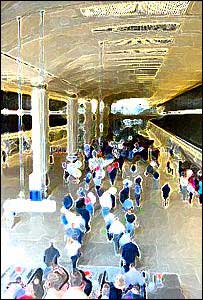 Architect Claire Price explains how to harvest the energy expended from footsteps and the vibrations from trains.
Architect Claire Price explains how to harvest the energy expended from footsteps and the vibrations from trains.
Energy harvesting was pioneered by the military sector, largely bankrolled by the DARPA, in a bid to reduce the need for soldiers to carry batteries for their communication devices. So they’ve looked at how “heel-strike” generators, powered through the pumping motion of a footstep, can be embedded within a boot heel. These devices currently achieve upwards of 3 – 6 watts of power output (see also power-generating backpack and Electrical human bodies).
Your body at rest is emitting about 100 watts into the environment. Now the 34,000 commuters who pass through Victoria underground station in London at rush hour could theoretically generate enough energy to power 6,500 LED light fittings.
Elsewhere in the world, researchers are also looking into how energy harvesting devices can be embedded within roads or how they can be used to create a self-powering heart pacemaker or even an artificial limb.
For railway arches, rather than merely trying to dampen the noise and vibration, Claire Price architectural practice is trying to harness this energy to help light buildings.
They are also applying and testing the ideas within a building project, including a sprung floor fitted with heel-strike generations to harvest the energy from people walking across it. This power output will then be wired back to provide the lighting within that building.
Besides, they plan an LED light fitting with its own micro generator. This unit will convert vibrations from passing trains, lorries or planes to provide continuous light without the need for wiring into the grid.
This could potentially mean considerable savings by omitting the need for the costly digging and laying of cables.
Via archinect BBC News.
